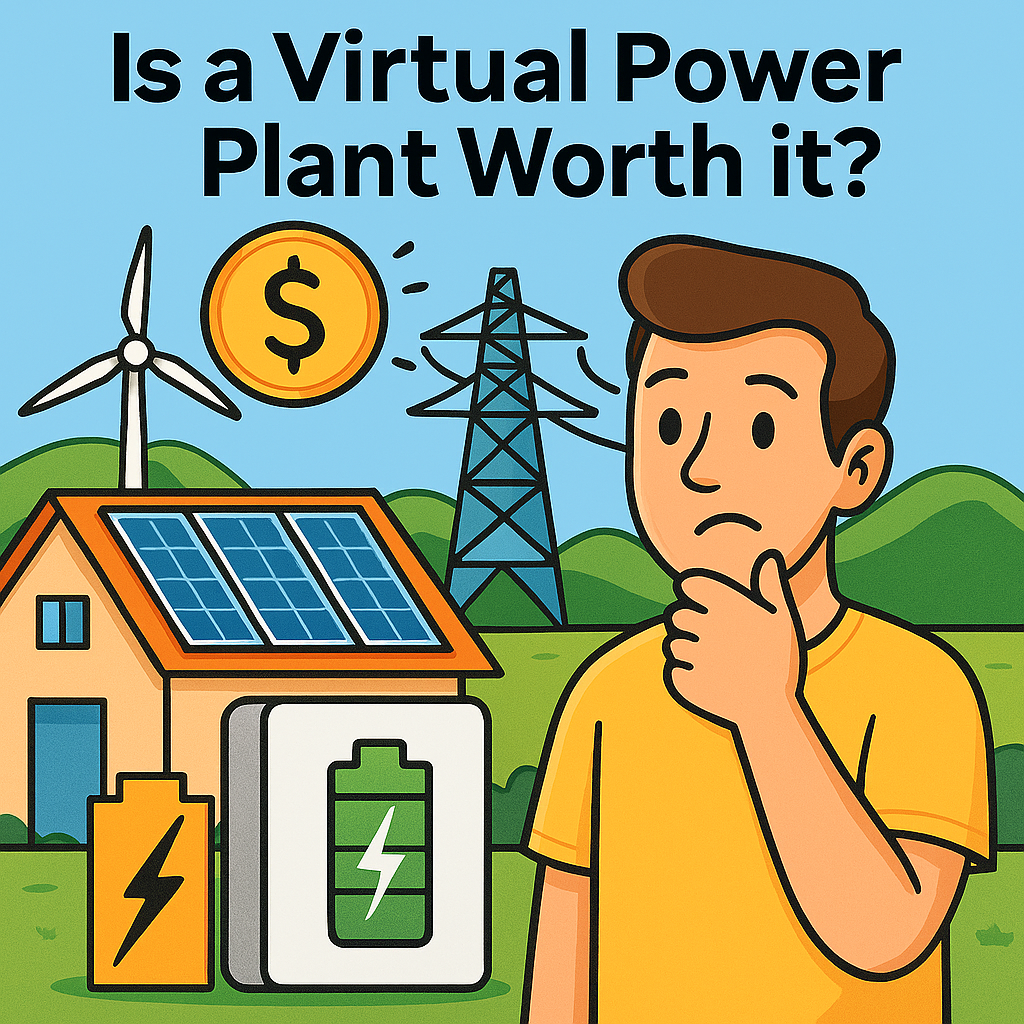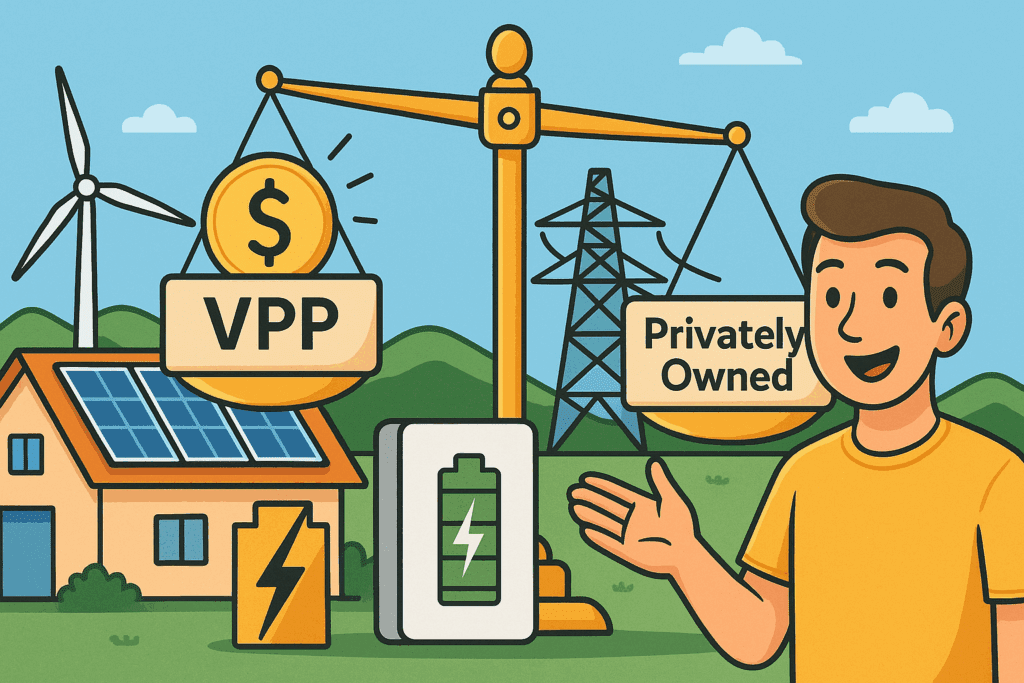So you’ve purchased or are about to purchase a solar battery. Now you’re asking is joining a Virtual Power Plant (VPP) worth it in 2025? VPPs offer access to wholesale energy markets, allow households to stack multiple home battery rebates, and contribute to grid reliability. But they also come with serious trade-offs including reduced solar battery control, contract obligations, and variable payouts. This guide explores whether a VPP is right for your home using verified examples and updated rebate information.
Learn more about how VPPs work on the Homeowners Ultimate Guide to VPPs page.
Table of contents
Pros and Cons of Virtual Power Plants (VPPs)
| Pros | Cons |
|---|---|
| Earn money from your battery Some VPPs pay up to $1/kWh during peak demand events. Others offer FCAS (Frequency Control Ancillary Services) payments for helping stabilise the grid. | Hard to track your actual battery use or earnings Leading VPPs offer real-time dashboards, but AEMO has raised concerns around consumer visibility. Some providers still don’t deliver clear post-event summaries or earnings breakdowns. |
| Lower battery costs and access to rebates Joining a VPP may unlock exclusive battery discounts, sign-up bonuses, and extra rebates. In NSW and WA, VPP participation is required to access some incentive programs. | Earnings are difficult to predict Returns depend on market conditions and VPP dispatch events, which vary week to week. Fixed payments are more predictable but may be lower. |
| Stack multiple solar and battery incentives Combine VPP income with feed-in tariffs, battery rebates, and monthly bill credits to maximise ROI. | Terms and conditions can be complex Each VPP has different rules. Review contract lengths, reserve settings, battery brand compatibility, and potential exit fees. |
| Smarter energy automation Many VPPs use AI and price forecasting to optimise battery use, with no manual intervention required. | You may lose battery control Some VPPs can remotely discharge your battery, which may reduce backup capacity during outages. Not all allow custom reserve settings. |
| Support Australia’s clean energy future By reducing peak demand and fossil fuel reliance, VPPs accelerate the transition to distributed, renewable energy. | Battery wear and hidden energy costs Frequent cycling and grid charging can reduce battery lifespan or lower long-term savings. Check the warranty and throughput limits. |
Benefits of Joining a VPP in 2025
1. Higher Earnings from Wholesale Market Access
When electricity prices surge during peak demand, your battery can export power to the grid and earn more than a standard feed-in tariff.
For example, on 17 May 2021, the wholesale price spiked to around $6 per kilowatt hour.
Example returns include:
- Time-sensitive export rates up to $1.00/kWh (e.g. Origin Loop)
- Monthly bill credits between $20 and $80
- One-off participation bonuses such as $200 sign-up credits
2. Eligibility for Stacked Rebates and Incentives
Homeowners who join a VPP may qualify for:
- Federal Battery Rebate of up to 30% off the cost of a battery
- NSW VPP incentive of $400
- WA battery discount of $2,000 (requires VPP participation)
3. Participation in Grid Stability Services (FCAS)
Some VPP programs support the Frequency Control Ancillary Services (FCAS) market by allowing your battery to quickly absorb or release power to help balance grid frequency.
This reduces blackout risks and may offer additional compensation for providing grid services.
4. Battery Automation and Optimisation
VPPs automatically manage your battery to:
- Charge from rooftop solar during daylight hours
- Discharge during peak price periods
- Operate without manual intervention
This helps maximise return on investment by optimising storage cycles.
5. Support for the Renewable Energy Transition
VPPs reduce the need for fossil-fuel power plants and enable higher levels of rooftop solar integration. This supports grid decarbonisation and positions homeowners as active participants in the energy transition.
Downsides of Joining a VPP
1. Reduced Manual Control of Your Battery
Some VPP programs restrict:
- Custom reserve settings for blackout protection
- Ability to pause export during grid instability
- Manual override functions
Look for providers that allow user-defined reserves such as Redback and Amber SmartShift.
2. Unpredictable Earnings
Returns from VPP participation vary based on:
- Real-time energy market volatility
- Frequency of VPP dispatch events
- Size and discharge capacity of your battery
Some programs offer fixed monthly credits, while others rely entirely on market-based earnings.
3. Contractual Obligations and Fine Print
Before enrolling, check:
- Contract length (some are five to seven years)
- Exit fees and clawback terms
- Lock-in with a specific energy retailer (e.g. Origin, Discover Energy)
- Battery and inverter compatibility
4. Limited Transparency and Reporting
Not all providers offer access to:
- Real-time performance logs
- Event summaries
- Mobile apps for monitoring and control
Prefer providers with visible export data and detailed reporting tools.
5. Increased Battery Wear from Additional Cycling
VPPs increase the number of charge and discharge cycles, which may:
- Accelerate wear and shorten battery lifespan
- Affect compliance with cycle-based warranties
Review the throughput limits in the manufacturer’s warranty documentation before committing.
6. Equity and Energy Efficiency Concerns
- Households with larger systems benefit more from VPP income
- Smaller battery setups may see negligible financial returns
- Some programs charge your battery using grid electricity, resulting in lower net benefits
Comparison Table: VPP vs Private Battery Use
| Feature | VPP Participation | Private Battery Use Only |
|---|---|---|
| Earnings Potential | High (wholesale access or fixed credit) | Low (feed-in tariff only) |
| Backup Power Availability | Limited (provider reserve settings apply) | Full manual control |
| Access to Rebates | Often higher with VPP-linked offers | Standard government rebates only |
| System Management | Automated THE vpp CONTROLS | Manual control required |
| Contract Flexibility | Varies (some long-term contracts apply especially if you’re buying a batery 5+years & clawbacks) | Full autonomy |
Is Joining a Virtual Power Plant Worth It in 2025?

Whether a Virtual Power Plant (VPP) is worth it depends on your goals, system size, and how much control you want over your battery.
A VPP may be worth it if you:
- Have a VPP-compatible battery and inverter
- Qualify for federal or state battery rebates
- Are comfortable allowing your battery to be automated and discharged by a third party
- Want to maximise your return through energy trading, FCAS income, or sign-up bonuses
It may not be ideal if you:
- Prioritise full control over your battery’s backup reserve settings
- Have a small system with low solar exports
- Prefer simple billing without market exposure or third-party control
- Are not comfortable with long contracts or exit fees
Key factors to consider include:
- Your battery size and throughput limits
- Whether the VPP allows blackout protection reserves
- How transparent the provider is with reporting and payout summaries
- If the program requires retailer lock-in or switching electricity providers
For many households, joining a VPP can shorten battery payback time and deliver higher long-term savings—especially when combined with rebates and high wholesale price events. But understanding the terms and your energy profile is essential before signing up.
Estimate Your Payback Period with a VPP
Use the Advanced Battery Payback Calculator to compare:
- VPP vs non-VPP return on investment
- How rebates affect total cost
- Realistic payback timelines for your setup
Frequently Asked Questions
Do VPPs affect blackout protection?
Only some VPPs allow reserve amount for a homes personal backup power. Check the provider’s terms before enrolling.
Can I leave a VPP after joining?
It depends. Some allow flexible exit (e.g. Amber, Redback), while others impose exit fees or contract terms.
Which VPP offers the highest earnings?
Amber SmartShift offers access to real-time spot pricing, which can outperform flat feed-in tariffs during peak events, though results vary.
- QLD Solar Rebate for Renters: Landlords & Tenants Guide - 6 January, 2026
- Air Conditioners Compared Australia | Independent Homeowners Guide (2026) - 23 December, 2025
- Changes To Cheaper Home Batteries Program | Homeowners Guide | Coming 1 May 2026 - 15 December, 2025
